Innovation Methods
Feb 25, 2024
By Ari Manor , CEO at ZOOZ

This is one in a series of articles that provide detailed and updated information about Innovation. In this specific article, which focuses on Innovation Methods, you can read about:
- Innovation Methods
- Innovation Methods VS Innovation Tools
- Systematic Innovation
- Systematic Innovation Workshops
- Agile Development
- Design Thinking
- Internal Screening
- Idea Funnel
- MVP and Lean Startup
- Rapid Prototyping
- Open Innovation
- Radical Innovation
For additional articles about Innovation, see the Topic Menu.
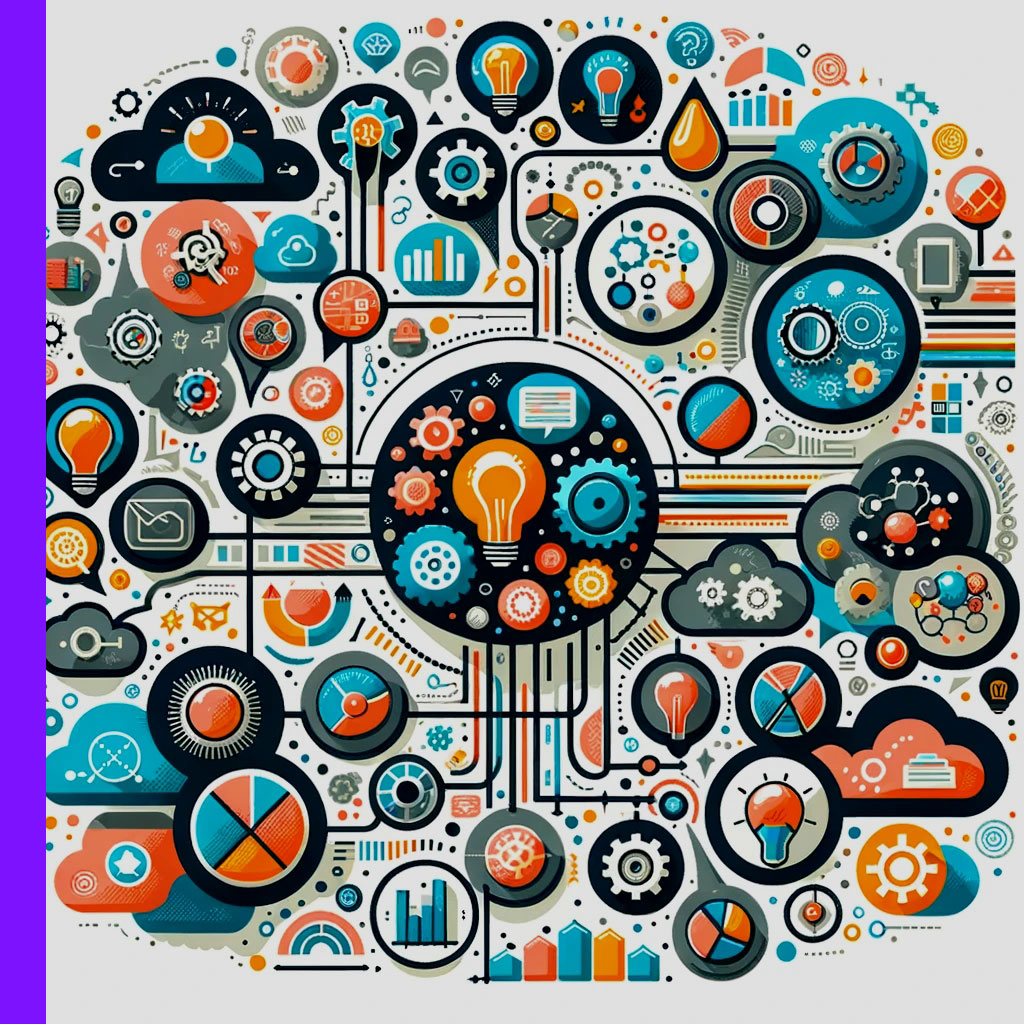
Innovation Methods
Innovation methods serve as the backbone of the innovation process, providing structured frameworks that guide organizations from the spark of an idea to its realization in the market. These methods are essential for creating a systematic approach to innovation, ensuring that efforts are not just sporadic bursts of creativity, but part of a coherent strategy aimed at delivering sustainable value.
Following are some common methods used to enhanced and manage Innovation processes.
Common Innovation Methods
- Systematic Inventive Thinking (SIT): A method focusing on inside-the-box thinking, utilizing proven thinking tools, and existing resources and constraints to generate new ideas in product, problem solving and advertising.
- Lean Startup: Emphasizes rapid prototyping, testing, and iteration to bring products to market more quickly and efficiently.
- Stage-Gate Process: A project management technique that divides the innovation process into stages, separated by gates where decisions are made to continue or halt the project.
- Design Thinking: A human-centered approach to innovation that integrates the needs of people, the possibilities of technology, and the requirements for business success.
- Agile Development: An iterative approach to software development and project management that helps teams deliver value to their customers faster and with fewer headaches.
- Open Innovation: Leverages external and internal ideas and paths to market as organizations look to advance their technology and solutions.
- Blue Ocean Strategy: Encourages creating new market space or "Blue Ocean" making the competition irrelevant.
- Jobs to Be Done (JTBD): Focuses on understanding the customer's desire to "hire" a product or service to get a job done.
- TRIZ: A systematic approach to innovation that uses over 100 patterns of problem-solving from past inventions to address new challenges creatively.
The Importance of Innovation Methods
Innovation methods are crucial for several reasons, including:
- Structured Approach: They provide a structured approach to navigating the complex process of innovation.
- Risk Mitigation: By following a proven framework, organizations can reduce the inherent risks associated with innovation.
- Enhanced Creativity: These methods often encourage looking at problems and opportunities from new angles, enhancing creativity.
- Customer Focus: Many innovation methods emphasize understanding and meeting the needs of customers, ensuring that innovations are market-driven.
In conclusion, innovation methods are indispensable tools in the arsenal of any organization aiming to thrive in today’s fast-paced and competitive environment. By adopting and adapting these methods to their unique contexts, organizations can foster a culture of innovation that consistently generates value for customers and stakeholders alike.

Innovation Methods VS Innovation Tools
Innovation methods and innovation tools are both essential components of the innovation process, but they serve different purposes and operate at different levels of the innovation framework. Understanding the distinction between them is crucial for effectively managing and fostering innovation within an organization.
Innovation Methods
Innovation methods refer to the overarching approaches or methodologies that guide the innovation process. These methods provide a systematic framework for generating, developing, and implementing innovative ideas. They often encompass a set of principles, stages, and practices designed to foster creativity, encourage collaboration, and manage the development of new products, services, or processes.
Examples of innovation methods include:
- Design Thinking: A human-centered approach to innovation that integrates the needs of people, the possibilities of technology, and the requirements for business success.
- Lean Startup: A methodology that focuses on creating and managing startups and new ventures by developing a minimum viable product, measuring how it performs, and learning from the results.
- Open Innovation: An approach that emphasizes using external as well as internal ideas and paths to market as organizations look to advance their technology and innovations.
- Agile Innovation: An approach that applies agile development methodologies to the innovation process, emphasizing speed, flexibility, and customer feedback.
- Systematic Inventive Thinking (SIT): A method focusing on inside-the-box thinking, utilizing proven thinking tools, and existing resources and constraints, to generate new ideas in product, problem solving and advertising.
Innovation Tools
Innovation tools are specific techniques, software, or instruments used to support the activities and tasks within the innovation methods. These tools are more tactical and can be applied at various stages of the innovation process to help generate ideas, evaluate concepts, prototype solutions, or manage projects.
Examples of innovation tools include:
- SCAMPER: Seven thinking tools that help generate improvements in product, service and process, fast.
- Mind Mapping: A visual tool used to structure information, helping to better analyze, comprehend, synthesize, recall, and generate new ideas.
- Prototyping Software: Digital tools that allow for the rapid creation and iteration of product prototypes.
- Root Cause Analysis (RCA): Identifies the root causes of issues for effective problem-solving.
Key Differences
- Scope and Application: Innovation methods provide a holistic framework or philosophy for approaching innovation, while innovation tools are specific techniques or aids used within those frameworks.
- Purpose: Methods are about the "how" of innovation—how to approach the process of creating something new. Tools are about the "what"—what techniques or aids can be employed to support that process.
- Flexibility: Methods are generally more flexible and adaptable to different organizational contexts and goals. Tools, on the other hand, are often more concrete and may be used in specific tasks or stages of the innovation process.
In summary, innovation methods and tools are complementary elements of an effective innovation strategy. Methods offer the structured approaches needed to navigate the complexity of innovation, while tools provide the practical support needed to execute those approaches. Together, they enable organizations to systematically innovate and bring new ideas to fruition.
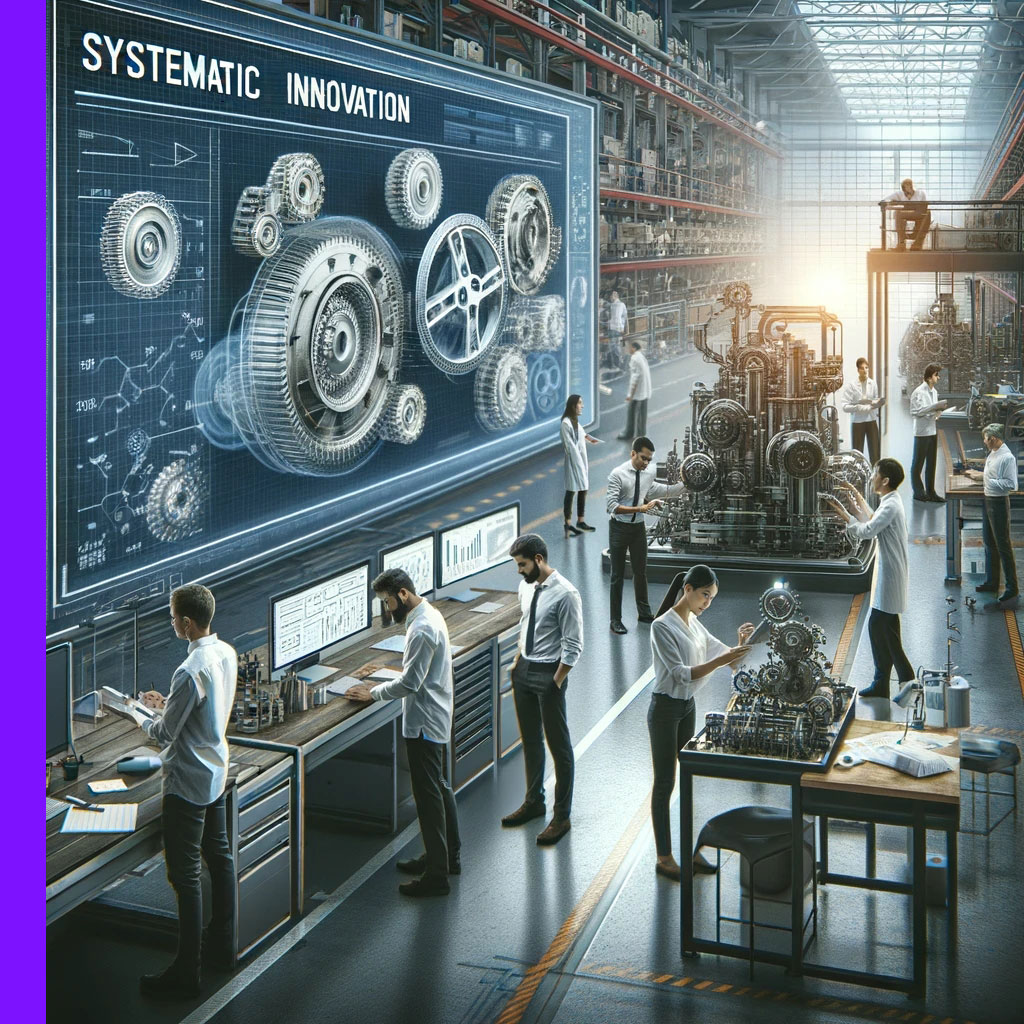
Systematic Innovation
Systematic innovation stands as a structured approach to generating, developing, and implementing innovative solutions. Unlike spontaneous or ad-hoc innovation, systematic innovation relies on defined processes, methodologies, and tools to uncover and exploit opportunities for innovation consistently. This approach aims to make innovation repeatable, scalable, and sustainable within organizations, ensuring that creativity and novel problem-solving are integral, ongoing aspects of business operations. A systematic approach to innovation also eliminates various risks, and yields a far better ROI on innovation processes.
Core Elements of Systematic Innovation
- Structured Processes: Systematic innovation involves clear stages or phases, from idea generation and selection to development and commercialization. Each phase has defined activities, objectives, and outcomes.
- Methodologies and Tools: It employs specific methodologies and tools designed to stimulate creative thinking, solve complex problems, and identify opportunities for innovation. Examples include TRIZ, SIT, Design Thinking, and the Stage-Gate Process.
- Cross-functional Teams: Innovation is fostered through collaboration among teams that bring diverse skills, knowledge, and perspectives. Systematic innovation structures this collaboration to maximize the generation of value-added ideas.
- Innovation Culture: A culture that supports risk-taking, values creativity, and encourages experimentation is essential. Systematic innovation embeds these values into the organizational fabric through policies, incentives, and leadership.
- Continuous Improvement: There is an emphasis on learning and continuous improvement, with feedback loops and mechanisms for capturing lessons learned and applying them to future innovation efforts.
Benefits of Systematic Innovation
- Predictability: By following a structured approach, organizations can make innovation more predictable and manageable, reducing the uncertainty and risk typically associated with innovation.
- Efficiency: Systematic processes help streamline innovation efforts, making better use of resources and potentially reducing the time to market for new ideas.
- Scalability: A systematic approach can be scaled across the organization, ensuring that innovation is not confined to specific departments or innovation labs but is pervasive throughout.
- Quality of Ideas: Employing structured methodologies can improve the quality and feasibility of ideas generated, ensuring that they are aligned with strategic goals and market needs.
Implementing Systematic Innovation
- Define the Innovation Strategy: Establish a clear framework for innovation.
- Fields of Innovation: Will it be in products, services, technology, business models, operations, distribution, HR, or multiple areas, perhaps even all?
- Level of Innovation: Should it be incremental or revolutionary? Will the innovations be new to the company, to the country, or to the world, or a combination thereof?
- Pace of Innovation: Is the goal to launch 1, 10, or 100 new products per year?
- Innovation Targets: What percentage of revenues should come from new products? How many patents should be registered per year? How many new customers should be acquired per month? What is the growth target in new territories?
- Resources for Innovation: Who will be responsible for Innovation Management? What budget and manpower will be dedicated to innovation efforts? Which Think Tanks and forums will be established? Are these resources sufficient to support the defined innovation goals?
- Define the Innovation Process: Establish clear stages for your innovation process, from ideation to implementation, and define the activities and outcomes expected at each stage.
- Select and Train on Methodologies: Choose innovation methodologies and tools that align with your organization's needs and culture. Provide training to employees to ensure they are effectively utilized.
- Foster an Enabling Culture: Cultivate an organizational culture that supports innovation through leadership endorsement, appropriate incentives, and recognition of innovative efforts.
- Encourage Cross-functional Collaboration: Create mechanisms for cross-functional teams to work together on innovation projects, leveraging diverse perspectives for richer, more comprehensive solutions.
- Measure and Adapt: Establish metrics to measure the effectiveness of your innovation efforts. Use these insights to continuously refine and improve your systematic innovation process.
Challenges in Systematic Innovation
- Over-structuring: There's a risk of over-structuring the innovation process, which can stifle creativity and flexibility. Finding the right balance between structure and freedom is crucial.
- Cultural Resistance: Embedding a systematic approach to innovation may face resistance from an organizational culture accustomed to traditional ways of working.
- Keeping Pace with Change: Ensuring that systematic innovation processes remain agile and adaptable in the face of rapid technological and market changes can be challenging.
How to Overcome these Challenges
- Overcoming Over-structuring in Systematic Innovation
- Foster a Flexible Framework: Establish an innovation process that allows for flexibility and spontaneous creativity within a structured approach.
- Encourage Experimentation: Allocate time and resources for free exploration, where employees can work on projects outside the structured innovation process.
- Regularly Review Processes: Periodically assess the innovation process to ensure it remains conducive to creativity and not overly restrictive.
- Tackling Cultural Resistance to Systematic Innovation
- Leadership Endorsement: Secure top management support to champion systematic innovation and its value.
- Incremental Implementation: Gradually introduce systematic innovation practices to allow time for cultural adaptation.
- Celebrate Successes: Highlight and celebrate early wins from the systematic innovation approach to build momentum and buy-in.
- Provide Training and Resources: Equip employees with the knowledge and tools they need to engage with the new system comfortably.
- Keeping Pace with Change through Systematic Innovation
- Embed Agility: Integrate agile methodologies into the innovation process to enhance responsiveness to change.
- Continuous Learning: Foster a culture of continuous learning to keep abreast of technological and market trends.
- External Collaboration: Partner with external entities, such as startups or research institutions, to gain fresh insights and stay ahead of industry shifts.
- Feedback Loops: Establish mechanisms for regular feedback from customers and frontline employees to quickly adapt innovations to changing needs.
In conclusion, Systematic Innovation provides a framework for making innovation a repeatable, sustainable aspect of business operations. By employing structured processes, methodologies, and fostering a supportive culture, organizations can enhance their innovation capabilities, leading to sustained competitive advantage and growth.
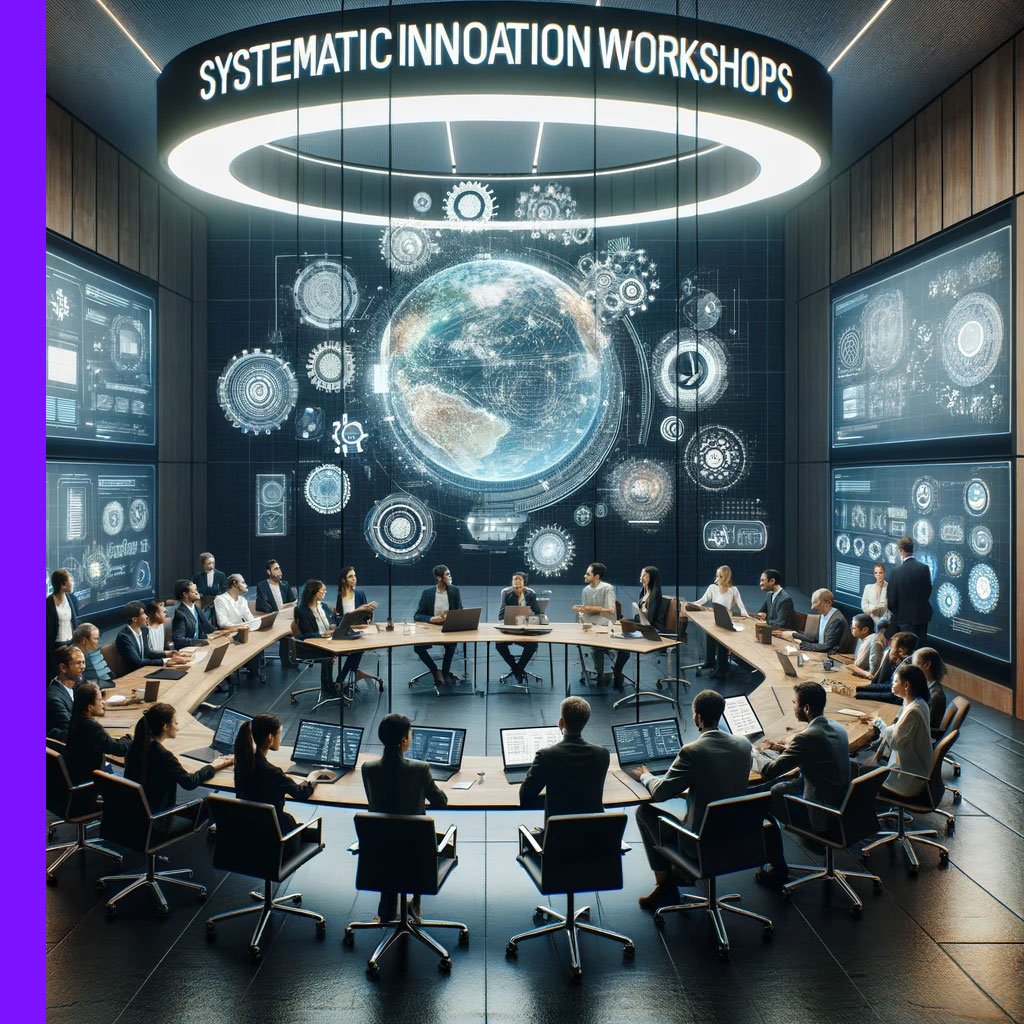
Systematic Innovation™ Workshops
Systematic Innovation™ workshops are designed to equip organizations with the processes and tools needed to manage innovation effectively across all innovation types (strategic innovation, organizational innovation, product and service innovation, and technological innovation) and across all innovation process stages (e.g., defining problems, idea generation, screening, prototyping, testing, commercializing, and promoting).
The Systematic Innovation™ methodology was developed by us (ZOOZ consultancy), following over 25 years of experience in leading innovation workshops with hundreds of organizations from various industries and countries. In essence, this methodology incorporates systematic and highly effective practices, thinking tools and management processes for all innovation aspects.
Our approach to helping organizations excel in innovation is simple: we work with organizations in-house, with internal and dedicated teams, on real cases, by selecting the proper thinking tools for each task and then applying selected systematic methods every step of the way. The framework is usually several days of highly practical workshops, and each tool is demonstrated then applied to organizations’ actual products, services, processes, technologies, problems, and/or strategies. For example, we use Systematic Inventive Thinking, De Bono's Six Thinking Hats, internal screening and concept testing combined, to generate, develop and screen a comprehensive and prioritized idea bank for product or service innovation, within a few days.
By focusing on practical outcomes, such as generating dozens of actionable ideas for new products and services, these workshops have a proven track record of leading to successful products and significant profits in a matter of months. Success stories span various industries, demonstrating the versatility and effectiveness of the methodologies taught.
Systematic Innovation™ Workshop Details
- Practical Focus: Using a major product or service as a starting point, workshops are grounded in real-world applications, ensuring relevance and immediate applicability. The resulting success stories, in turn, encourage the participants to keep using the tools and methods they learned.
- Careful tool selection: Matching the proper tools to the actual needs enhances results. For example, for idea generation, we use (or refrain from) the following:
- Brainstorming – a method that “feels” nice but brings poor results: usually, brainstorming can only predict up to 10% of all valid ideas for future innovation. Therefore, we NEVER use it!
- SCAMPER – seven thinking tools that can be taught in minutes and can predict 30% of all possible ideas for future innovation. We use it for short sessions (1-4 hours) with dozens of participants.
- Systematic Inventive Thinking (SIT) – six thinking tools that require hours to learn and apply but can predict 80% of future innovation - for longer sessions (1-3 days) with a think-tank of 8-12 members.
- TRIZ – a complex methodology with more than 100 tools (that take years to master). We prefer to offer external consulting by TRIZ experts to crack complicated issues organizations may face.
- Cross-Departmental Participation: Selecting the optimal Think Tank, with all relevant expertise. For example:
- For Strategic Innovation – The company management team, as well as board members if applicable (same people that will apply and supervise the updated strategy).
- For Product Innovation – Mainly marketing/product people (to represent the voice of the customer), with a few operations and/or R&D people (to confirm feasibility of ideas).
- For Technological Innovation – Engineers from several departments, which enables benchmarking and idea sharing across departments.
- Global Availability: Tailored to meet the needs of diverse industries worldwide, these workshops are adaptable and can be conducted globally, emphasizing the universal applicability of systematic innovation principles.
For further details, and for ordering Systematic Innovation™ Workshops for your organization, see here.
In summary, Systematic Innovation™ workshops offer a proven, practical framework for fostering innovation within organizations. By focusing on real-world applications and cross-functional collaboration, these workshops not only enhance the innovation process but also drive tangible business results, demonstrating their effectiveness across a wide range of industries and global markets.

Agile development
Agile Development is a methodology primarily used in software development that promotes continuous iteration of development and testing throughout the project lifecycle. It emphasizes flexibility, customer feedback, team collaboration, and the rapid delivery of high-quality products. This approach contrasts with traditional development methodologies that follow a linear, sequential process, often leading to slower adaptation to changing requirements.
Principles of Agile Development in Action
- Customer Collaboration: Agile Development insists on customer involvement at every stage, ensuring the end product is highly tailored to user needs. For example, Spotify uses Agile principles to continuously deploy, and update features based on user feedback, contributing to its over 345 million active users as of 2021.
- Iterative Process: Instead of one-time, big-launch developments, Agile focuses on small, frequent updates. This can be seen in the frequent software updates by Adobe Creative Cloud, enhancing user experience and functionality step by step.
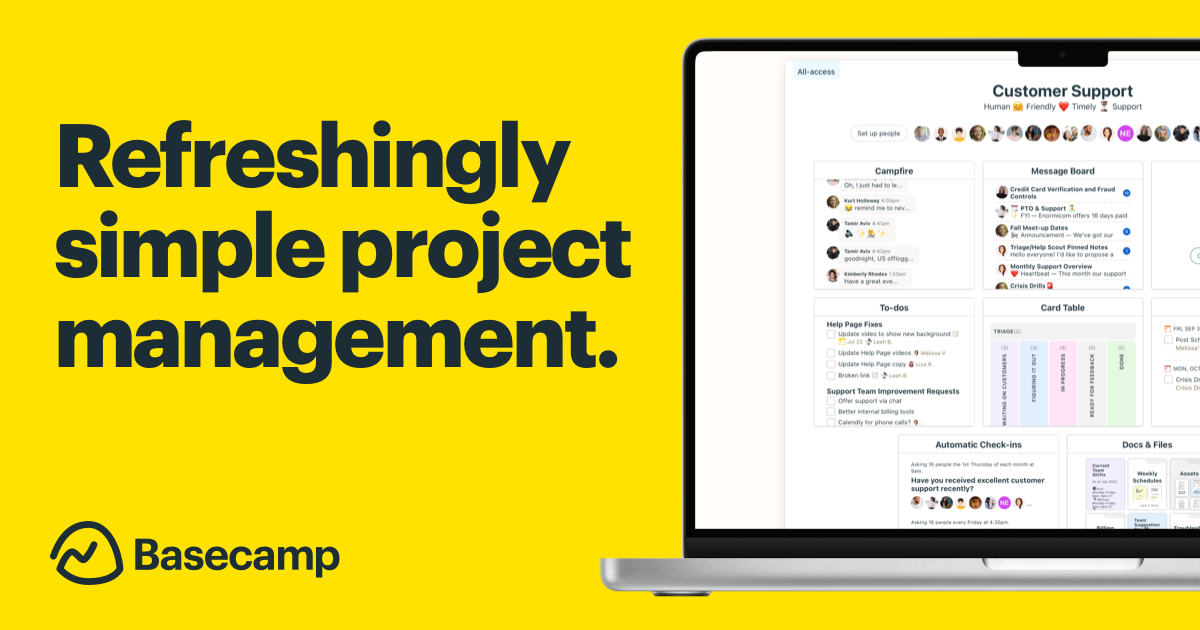 Case Study: Basecamp's Project Management Software
Case Study: Basecamp's Project Management Software- Organization: Basecamp, Chicago, Illinois, USA (Continuous updates)
- What Was Done: Basecamp uses agile development to regularly update its project management software, quickly adapting to changing customer needs and technological advancements.
- Results/Impact: Basecamp's agility has helped it maintain a competitive edge in the project management space, retaining a loyal user base and attracting new customers seeking intuitive and flexible tools.
- Cross-functional Teams: Agile teams are often cross-disciplinary, with members contributing diverse skills. Atlassian, the company behind tools like Jira and Trello, credits its success to Agile cross-functional teams, which have contributed to its valuation of over $50 billion.
- Embracing Change: Agile Development is open to changing requirements, even late in development. Microsoft’s shift to Agile has allowed for the constant evolution of its Office 365 suite, with monthly updates that refine and introduce features, keeping the product competitive and responsive to customer needs.
Quantitative Impacts of Agile Development
- Customer Satisfaction: Agile’s focus on customer needs has been shown to increase customer satisfaction rates. Salesforce, an early adopter of Agile, boasts a high customer satisfaction score, with reports showing over 90% of customers say the CRM meets their needs.
- Speed to Market: Agile Development can reduce time to market by 37% and increase efficiency by 16%, according to a report by the Project Management Institute.
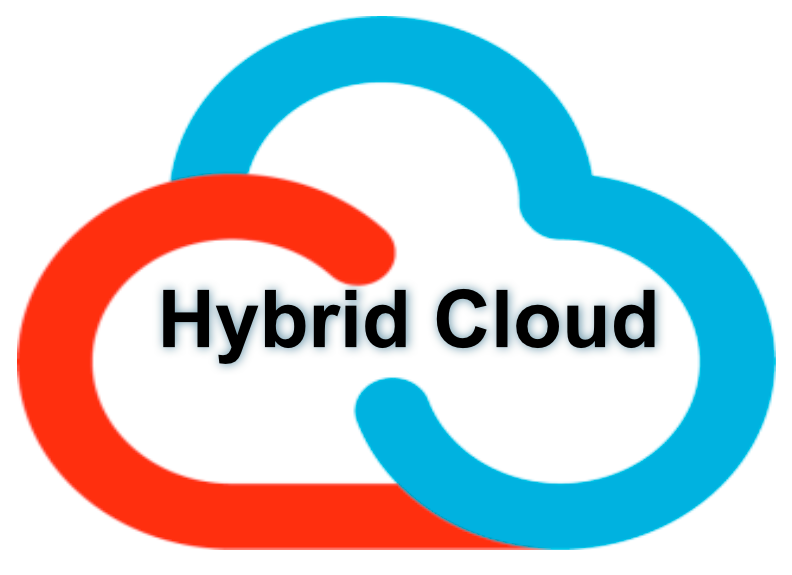 Case Study: IBM's Hybrid Cloud Development
Case Study: IBM's Hybrid Cloud Development- Organization: IBM, New York, USA (Implemented in the late 2010s)
- What Was Done: IBM adopted agile methodologies to accelerate the development of its hybrid cloud services, fostering collaboration and rapid iteration across its global teams.
- Results/Impact: The approach reduced the development cycle time, improved product quality, and increased customer satisfaction by rapidly delivering features in response to user feedback.
- Product Quality: By emphasizing continuous testing and iteration, Agile practices lead to higher product quality. Cisco reported a 40% decrease in critical defects and a 15% increase in defect removal efficiency after implementing Agile.
- Return on Investment: Agile projects are 28% more successful than traditional projects, leading to better return on investment. For instance, IBM reported a decrease in costs of up to 30% after adopting Agile practices.
Agile Development’s iterative, flexible approach has revolutionized the software industry and beyond, influencing how companies think about product development, customer engagement, and team dynamics. The methodology’s success is quantified not just in software performance metrics but also in broader business impacts, such as increased customer satisfaction, faster time to market, and overall financial performance. It represents a fundamental shift in project management that has become integral to innovation in the fast-paced digital age.

Design Thinking
Design Thinking is a non-linear, iterative process that teams use to understand users, challenge assumptions, redefine problems, and create innovative solutions to prototype and test. It's rooted in the belief that everyone can be part of creating a more desirable future, and that a systematic approach to innovation can produce user-centric products and services.
Core Stages of Design Thinking
- Empathize: Understanding the human needs involved.
- IDEO, a global design company, famously immerses itself in the user's environment to understand the nuances of their experiences, leading to user-centric product designs that resonate with millions worldwide.
- IDEO, a global design company, famously immerses itself in the user's environment to understand the nuances of their experiences, leading to user-centric product designs that resonate with millions worldwide.
- Define: Consolidating information gathered to define the core problems.
- The d.school at Stanford University teaches students to articulate user needs and behaviors to inform impactful design, which has led to successful startups and products.
- The d.school at Stanford University teaches students to articulate user needs and behaviors to inform impactful design, which has led to successful startups and products.
- Ideate: Brainstorming a range of creative solutions.
- Google, for example, holds ideation sessions that lead to a plethora of product ideas—many of which, like Google Maps and AdSense, have become indispensable to billions of users.
- Google, for example, holds ideation sessions that lead to a plethora of product ideas—many of which, like Google Maps and AdSense, have become indispensable to billions of users.
- Prototype: Creating a number of scaled-down versions of the product or specific features found within the product to test the concept.
- Airbnb’s prototype of a new website led to a double increase in revenues after realizing the importance of professional photography for property listings.
- Airbnb’s prototype of a new website led to a double increase in revenues after realizing the importance of professional photography for property listings.
- Test: Rigorous trial and error with the best solutions identified during the prototyping phase.
- Samsung’s iterative design process, often involving extensive user testing, has led to innovative products like the Galaxy Z Fold phone, carving out a niche in the competitive smartphone market.
Quantitative Impact of Design Thinking
- User Engagement: SAP, the enterprise software giant, attributed a 300% increase in user engagement to its adoption of Design Thinking as a strategy for product development.
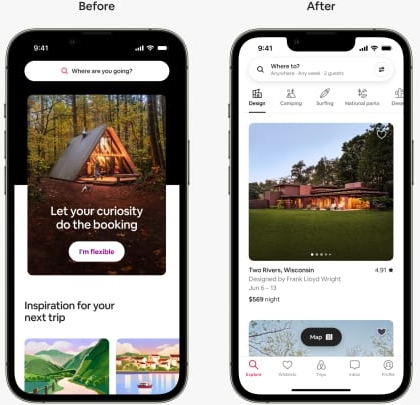 Case Study: Airbnb's User-Centric Platform Redesign
Case Study: Airbnb's User-Centric Platform Redesign- Company: Airbnb, San Francisco, California, USA (Redesign in 2014)
- What Was Done: Airbnb employed design thinking to overhaul its online platform, focusing on a user-friendly interface and an improved customer experience.
- Results/Impact: The redesign significantly increased bookings and user engagement, propelling Airbnb to become a leader in the hospitality industry.
- Cost Reduction: By applying Design Thinking, IBM reported a 75% reduction in design time and savings of $20 million in a single year due to more efficient product development processes.
- Revenue Growth: After implementing Design Thinking in their approach, Procter & Gamble saw a significant increase in their innovation success rate, from 15% to 50%, leading to a substantial growth in revenues.
 Case Study: P&G's Swiffer
Case Study: P&G's Swiffer- Organization: Procter & Gamble, Ohio, USA (Swifter Launched in 1999)
- What Was Done: P&G used design thinking to develop Swiffer, a cleaning system designed around user experience, which led to a new product category in the cleaning industry.
- Results/Impact: Swiffer became a household name, generating over $500 million in annual sales and spawning numerous spin-off products.
Design Thinking has become a strategic tool not only for designers but for everyone involved in the product development process. Its empathetic, customer-first approach has been quantitatively shown to lead to products that better meet user needs, reduce development costs, and significantly increase the success rate of new product introductions. Companies like IDEO, Google, and Airbnb have shown how applying Design Thinking principles can lead to breakthrough innovations and sustainable competitive advantages in the marketplace.
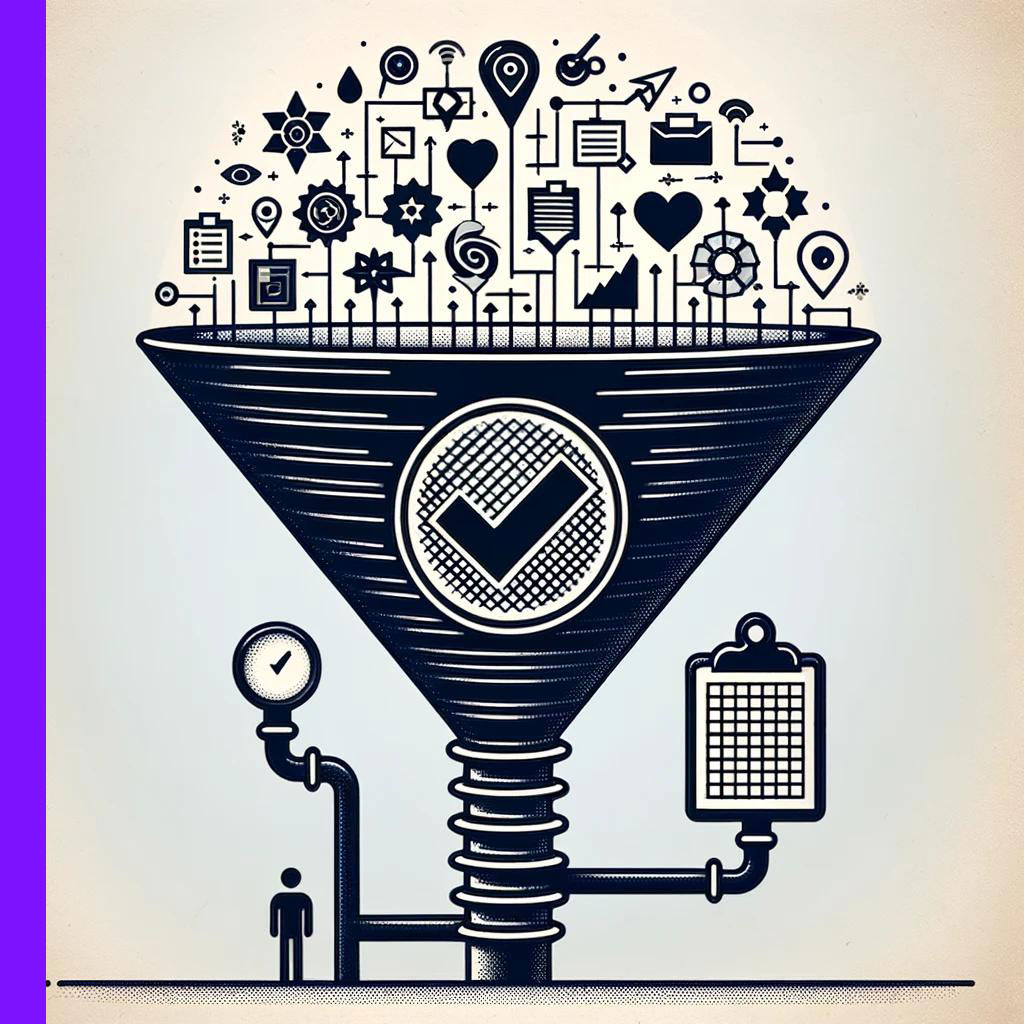
Internal Screening
Introduction to the Tool
Internal screening is a business strategy tool used to evaluate a company's ideas and projects against a set of predetermined criteria to determine their potential for success. Its origin lies in strategic management principles, focusing on maximizing the use of internal resources and capabilities to achieve competitive advantage.
Who should use it
- Corporate strategists and decision-makers
- Project managers
- Innovation teams
- R&D departments
- Startup founders
When to Use
- During the idea generation phase of product development
- When managing an Idea Bank
- Before committing resources to a project
- When prioritizing multiple projects or ideas
- In the annual planning cycle
Objectives
- To identify the most promising projects or ideas
- To allocate resources efficiently
- To minimize investment in non-viable projects
- To streamline the innovation pipeline
How to Use It
- Establish clear criteria for project evaluation.
- For example: feasibility, ROI, strategic fit, novelty
- For example: feasibility, ROI, strategic fit, novelty
- Collect a list of all ideas and projects to be screened.
- Score each project against the criteria.
- Rank the projects based on their scores.
For example, see the following table: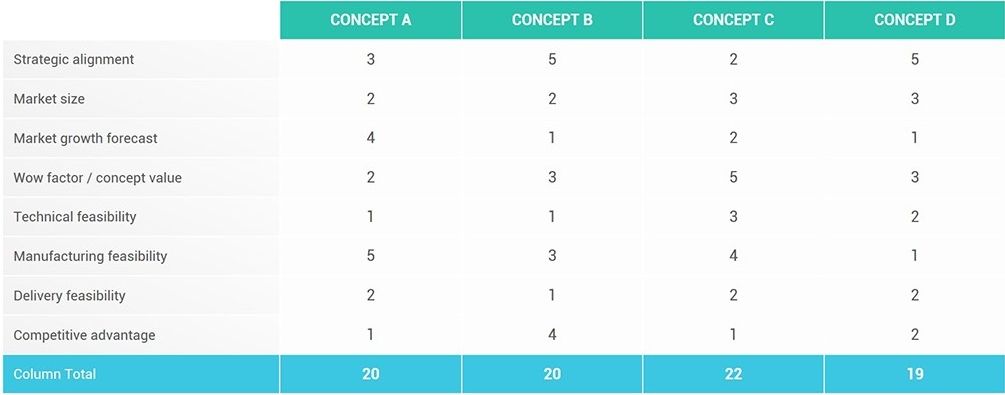
- Select the highest-ranking projects for further development.
Time Investment
- 2-4 hours
Expected Results
- A prioritized list of projects
- Better alignment of projects with strategic goals
- More effective resource allocation
Benefits
- Systematic approach to project evaluation
- Objective decision-making
- Enhanced project success rates
- Improved strategic focus
Limitations
- May overlook the potential of unconventional ideas
- Dependent on the quality of the screening criteria
- Can be time-consuming if not well-managed
Examples
- A tech company uses internal screening to select the most promising app concepts from a pool of ideas.
- A pharmaceutical firm applies internal screening to focus its R&D efforts on the drugs most likely to succeed in clinical trials.
Conclusion
Internal screening is an essential tool for organizations aiming to optimize their innovation processes. By systematically evaluating ideas against strategic criteria, companies can focus their efforts on the projects with the highest potential for success. While it requires careful planning and implementation, the benefits of informed decision-making and efficient resource allocation make it a valuable tool in the business arsenal.
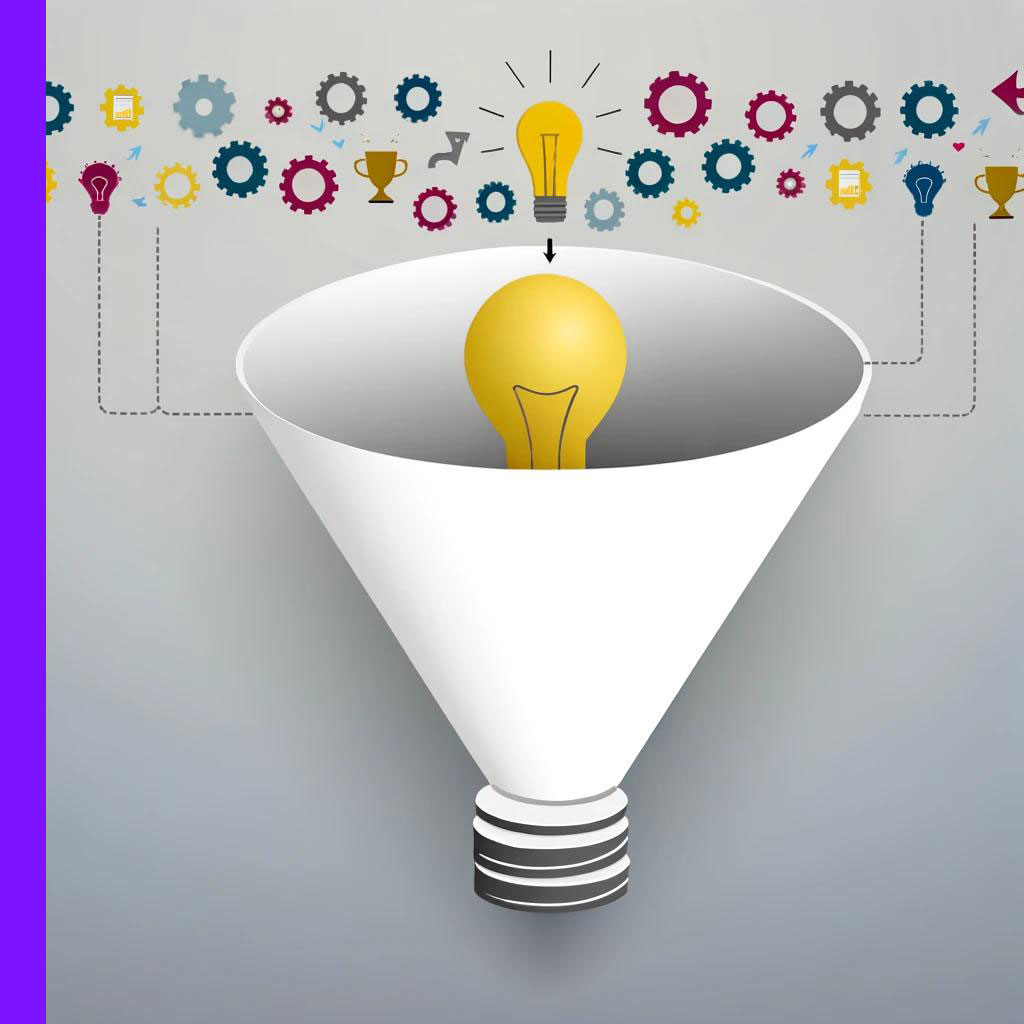
Idea Funnel
Introduction to the Tool
The idea funnel is a metaphorical concept used in business and innovation to represent the process of filtering numerous ideas to select the few that are viable for implementation. It mirrors the shape of a physical funnel, wide at the entry point for the generation of many ideas and narrowing towards the bottom where ideas are evaluated and refined.
Who should use it
- Business executives and managers
- Innovation and R&D teams
- Startups and entrepreneurs
- Marketing professionals
- Product managers
When to Use
- During the ideation phase of product development
- In strategic planning sessions
- When prioritizing innovation initiatives
- For campaign development in marketing
Objectives
- To manage the flow of ideas efficiently
- To prioritize ideas based on potential impact
- To streamline the decision-making process
- To allocate resources to the most promising ideas
How to Use It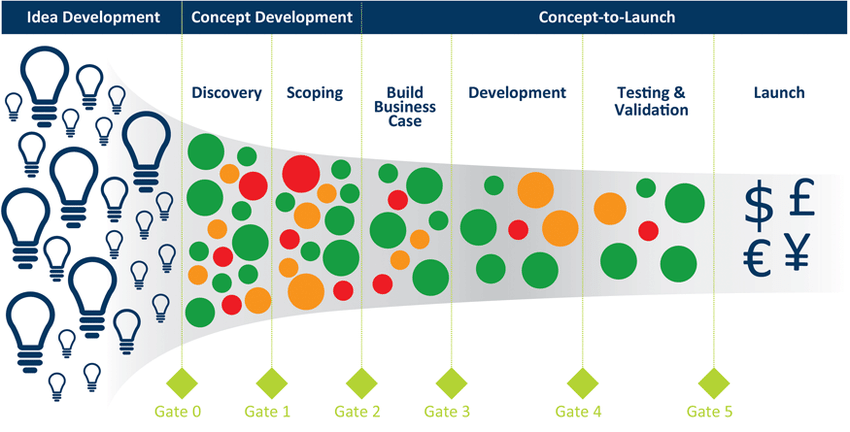
- Generate a wide range of ideas.
- Set initial filtering criteria based on strategic alignment and feasibility.
- Narrow down the ideas through successive stages of evaluation.
- Apply more specific criteria at each stage to further refine the selection.
- End with a shortlist of actionable ideas ready for development or testing.
Time Investment
- 1-3 hours
Expected Results
- Sorted and prioritized Idea Bank
- A manageable list of actionable ideas
- Increased focus on high-quality and strategic initiatives
- Improved alignment of ideas with business goals
Benefits
- Encourages broad thinking followed by strategic focus
- Efficiently narrows down options, saving time and resources
- Systematic approach to innovation
Limitations
- Dependent on the quality of the filtering criteria
- Can be biased by the facilitator's perspective
- May inadvertently filter out unconventional yet valuable ideas
Examples
- A consumer goods company uses an idea funnel to decide on new product lines.
- A digital agency employs the funnel to determine which marketing strategies to implement for a high-profile campaign.
Conclusion
The idea funnel is a practical and effective tool for distilling a multitude of ideas into a select few that are worth pursuing. It provides a structured approach to innovation, ensuring that only the most promising ideas receive the scarce and valuable resources required to bring them to life. This tool is instrumental for organizations that want to foster a disciplined yet creative approach to innovation.
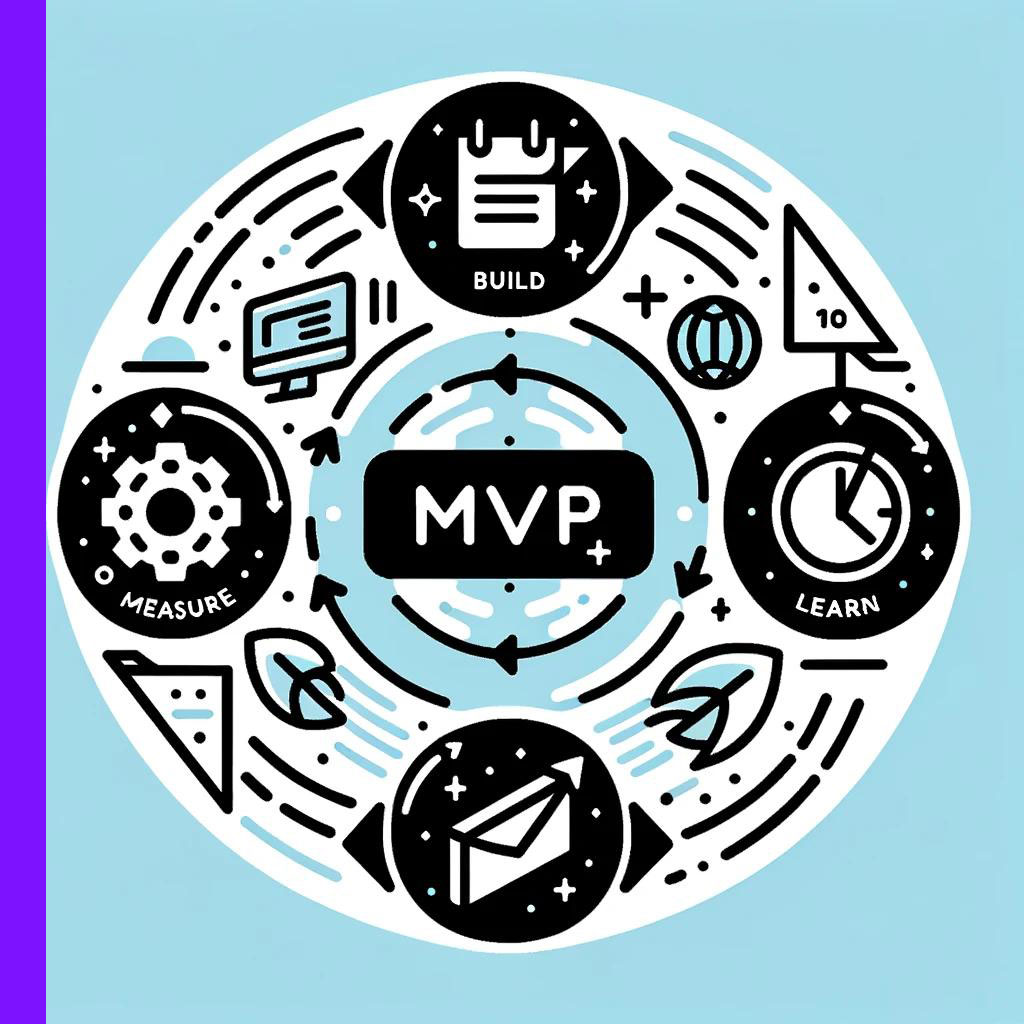
MVP and Lean Startup
Introduction to the Tool
Minimum Viable Product (MVP) and Lean Startup are closely related concepts in the world of startup development, introduced by Eric Ries. The MVP is the simplest version of a product that allows a team to collect the maximum amount of validated learning about customers with the least effort. The Lean Startup methodology is a business approach that favors experimentation overelaborate planning, customer feedback over intuition, and iterative design over traditional “big design up front” development.
Who should use it
- Startup founders
- Product managers
- Software developers
- Innovation labs
- Business school students
When to Use
- At the early stages of a new product or service development
- When validating a business idea
- For iterating and improving products based on customer feedback
- In fast-paced industries where quick adaptation is crucial
Objectives
- To quickly test and validate hypotheses about a business model
- To reduce waste by developing only what is necessary
- To accelerate learning through build-measure-learn feedback loops
How to Use It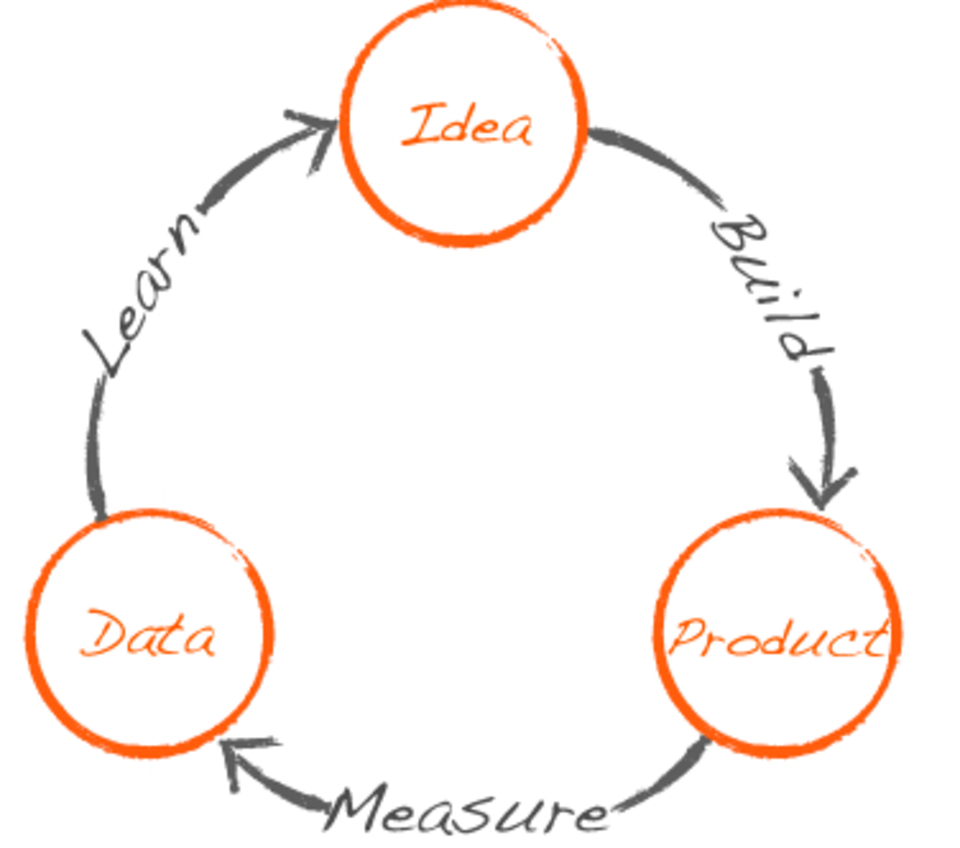
- Identify the core problem your product is solving.
- Define the minimum set of features needed to solve that problem, and create an MVP.
- Measure the MVP’s effectiveness in the market through customer interactions.
- Learn from the feedback and iterate on the product accordingly.
- Repeat the process, refining the business model and product each cycle.
Time Investment
- Varies greatly; could be weeks to months for initial cycles
Expected Results
- A better understanding of customer needs
- A product that is more closely aligned with market demands
- Faster iteration and development cycles
Benefits
- Minimizes time and resources spent on non-viable product features
- Helps to find a product-market fit more efficiently
- Encourages innovation and flexibility
Limitations
- May result in a less polished initial product
- Can be challenging to determine the true “minimum” set of viable features
- Risk of misunderstanding customer feedback
Examples
- A tech startup develops an MVP for a new app and uses customer feedback for improvements.
- An e-commerce company applies Lean Startup principles to test a new market strategy with a small investment before rolling it out broadly.
Conclusion
The MVP and Lean Startup approach is a powerful combination for any organization looking to innovate rapidly and efficiently. This method allows for real-world testing and learning, which is invaluable for aligning a product with the needs of its users. While it requires a culture comfortable with rapid iteration and occasional failure, the benefits of building a product that customers truly want can be immense.
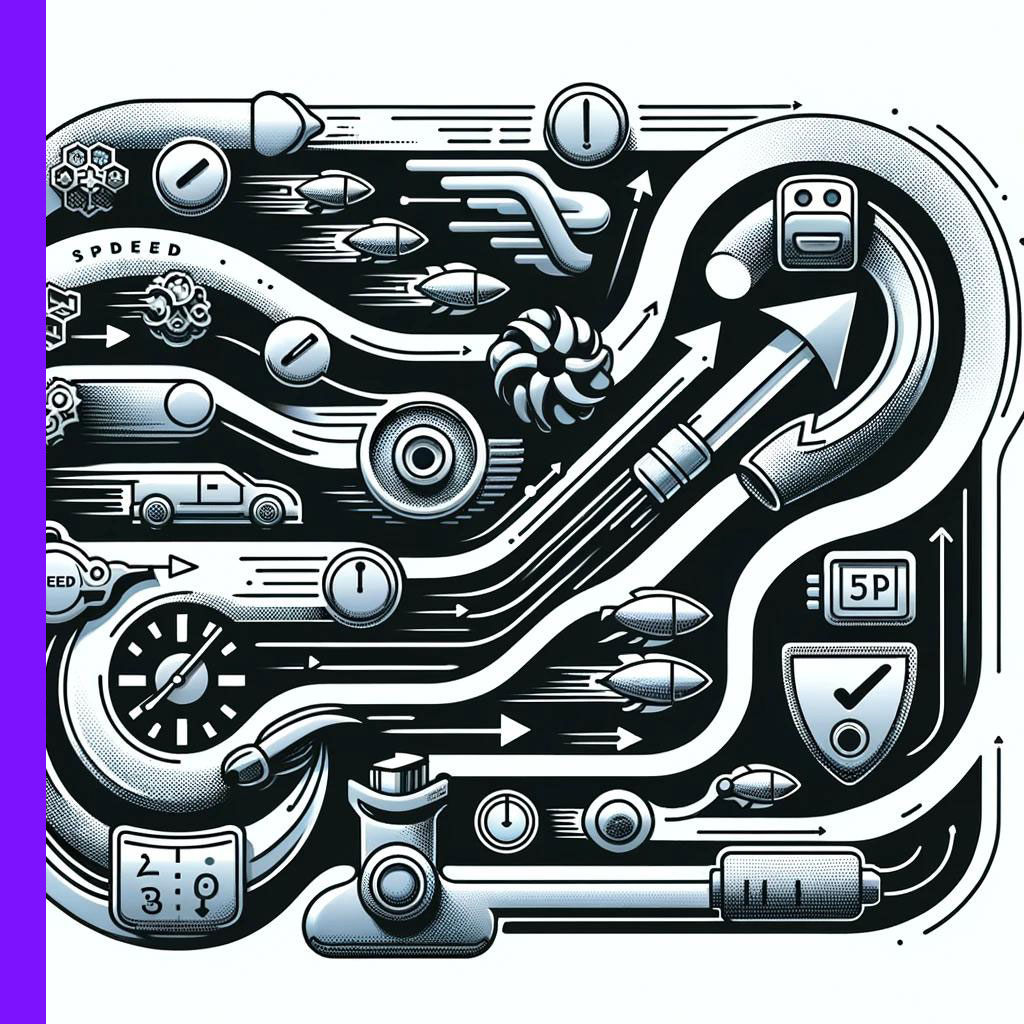
Rapid Prototyping
Introduction to the Tool
Rapid Prototyping is an iterative approach to the development of prototypes that allows teams to quickly create and evolve product models. This method is used to visualize and test the form, fit, and function of a design before final production, saving time and resources.
Who should use it
- Product designers
- Engineers
- Software developers
- User experience (UX) designers
- Innovators and inventors
When to Use
- In the early stages of product development
- When needing to test the feasibility of a design
- Before investing in full-scale production
- To quickly gather user feedback on a concept
Objectives
- To validate design concepts swiftly
- To identify design flaws early in the development process
- To incorporate user feedback rapidly into the design
- To accelerate the product development cycle
How to Use It
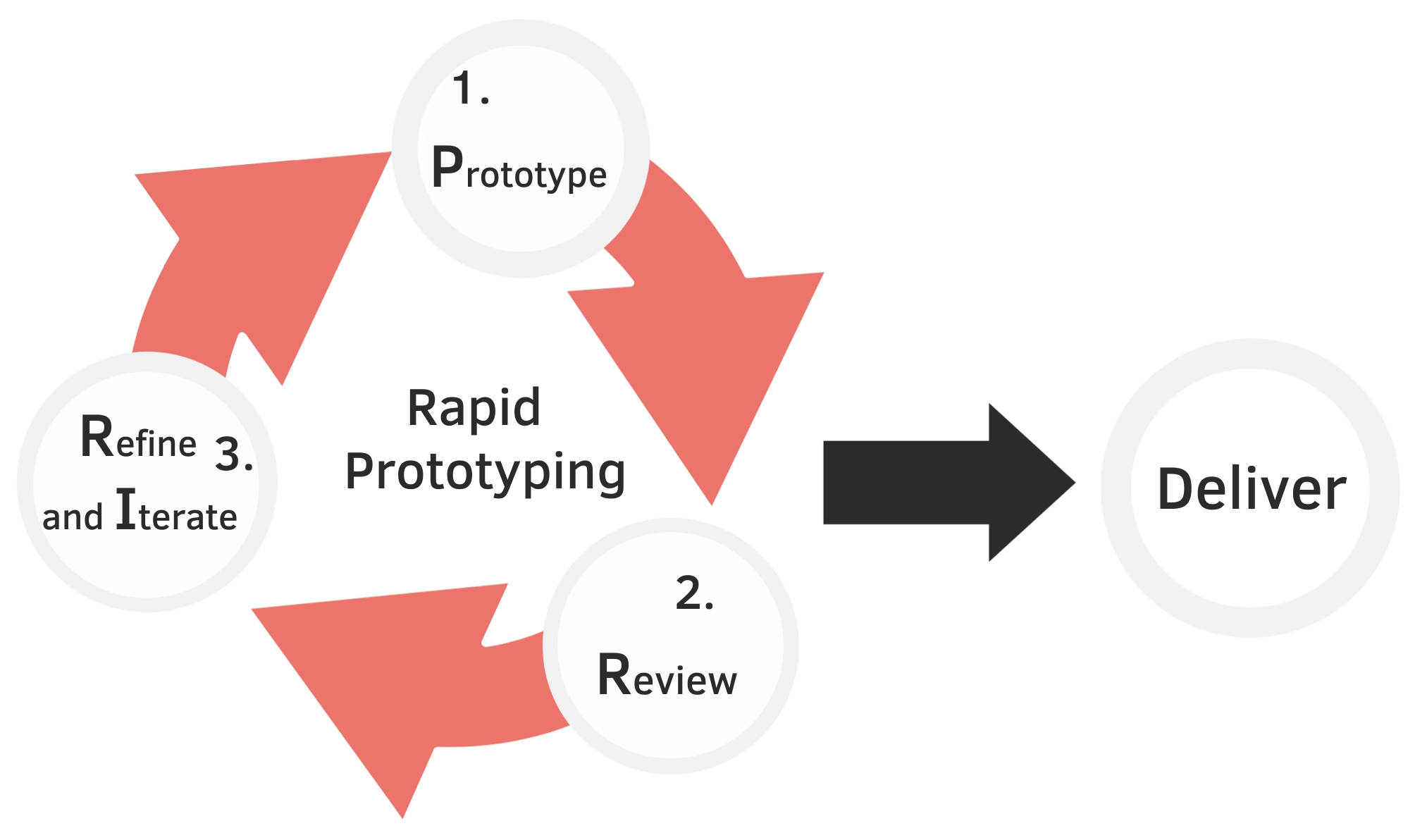
- Define the basic requirements and scope of the prototype.
- Choose a prototyping method suitable for the product
(3D printing, software simulation, etc.). - Develop the initial prototype based on the design concept.
- Test the prototype internally and with potential users.
- Collect feedback and refine the prototype iteratively.
- Repeat the cycle until the design meets the desired criteria
Time Investment
- Varies greatly; from a few hours to several weeks
Expected Results
- A series of improved prototypes based on iterative feedback
- A final design that is thoroughly tested and user-validated
- Shorter overall product development time
Benefits
- Speeds up the design process
- Enhances flexibility and adaptability in product development
- Improves the final product quality through iterative testing
Limitations
- May result in an oversimplified version of the final product
- The prototype may not always accurately represent the final functionality
- Costs can add up if many iterations are needed
Examples
- A tech company quickly prototypes a new smartphone case design using 3D printing.
- A software team develops a clickable mockup of a mobile application to test user experience.
Conclusion
Rapid prototyping is a valuable tool for modern product development, allowing teams to quickly visualize and test a design before committing to production. It promotes a user-centered approach to design, reduces development time, and helps prevent costly errors. While it may have limitations, the benefits of being able to adapt and evolve a product rapidly are significant in a competitive market.

Open Innovation
Open innovation is a paradigm that asserts organizations can and should use external ideas as well as internal ideas, and internal and external paths to market, as they look to advance their technology. It contrasts with the traditional closed innovation model that restricts innovation processes to the internal boundaries of an organization. Open innovation leverages the collective brainpower of external contributors, such as customers, researchers, startups, and even competitors, to drive innovation more efficiently and effectively.
Key Aspects of Open Innovation
- Inbound Open Innovation: This involves bringing external ideas and technologies into the organization to enhance its innovation projects. It can include partnerships with academic institutions, crowdsourcing, licensing technologies, or acquiring startups.
- Outbound Open Innovation: In this model, unused or underutilized internal ideas and technologies are taken outside the organization through spin-offs, licensing, or joint ventures, creating new revenue streams and opportunities for growth.
- Collaborative Open Innovation: This approach combines inbound and outbound strategies to collaborate with external partners on joint development projects, sharing risks, costs, and rewards.
Benefits of Open Innovation
- Increased Creativity and Diversity: Incorporating a wide range of external perspectives can lead to more creative solutions and a greater diversity of ideas.
- Accelerated Time to Market: Access to external ideas and technologies can significantly speed up the innovation process, from ideation to commercialization.
- Cost Efficiency: Sharing development costs and risks with external partners can make innovation projects more financially viable.
- Access to New Markets: Collaborating with partners in different regions or sectors can provide valuable insights and access to new markets.
Challenges in Implementing Open Innovation
- Intellectual Property Management: Navigating intellectual property rights and ensuring fair agreements can be complex and requires careful management.
- Cultural and Organizational Barriers: Adopting an open innovation model may require significant cultural shifts within an organization, particularly in moving away from the 'not invented here' syndrome.
- Quality Control: Ensuring the quality and feasibility of external ideas and maintaining the organization’s standards can be challenging.
Strategies for Successful Open Innovation
- Establish Clear Frameworks: Develop clear guidelines and frameworks for managing partnerships, intellectual property rights, and project governance.
- Foster a Culture of Collaboration: Encourage a culture that values external collaboration and open exchange of ideas, supported by leadership endorsement.
- Leverage Digital Platforms: Utilize digital platforms and tools, like InnoCentive and Kaggle, to facilitate collaboration, idea management, and integration of external innovations.
- Build Strategic Partnerships: Carefully select and cultivate partnerships with external organizations that share similar goals and values.
Open innovation represents a strategic shift in how organizations approach research and development, breaking down the barriers to innovation and leveraging the global community to drive progress. By embracing open innovation, companies can enhance their innovation capabilities, tap into new sources of ideas and technologies, and stay competitive in rapidly changing markets.

Radical Innovation
Radical innovation represents a significant departure from existing technologies, products, or business models, often leading to transformative changes in industries and society. Unlike incremental improvements, radical innovations introduce groundbreaking ideas that revolutionize the way we live, work, and interact. Embracing radical innovation requires a willingness to challenge the status quo, disrupt established norms, and pursue ambitious goals that push the boundaries of what is possible.
Embracing Radical Innovation
- Disruptive Technologies: Radical innovations often emerge from disruptive technologies that fundamentally change the way industries operate. Examples include blockchain technology, which has the potential to revolutionize finance, supply chain management, cybersecurity, and gene editing techniques like CRISPR-Cas9, which hold promise for curing genetic diseases and transforming healthcare.
- Transformative Business Models: Radical innovation extends beyond technological advancements to encompass novel business models that redefine industry dynamics. Companies like Airbnb and Uber have disrupted traditional hospitality and transportation industries by leveraging digital platforms to connect consumers with underutilized resources, such as spare rooms and vehicles, creating entirely new markets in the process.
- Cross-Disciplinary Collaboration: Radical innovation often requires collaboration across diverse disciplines, bringing together experts from different fields to tackle complex challenges. Initiatives like interdisciplinary research hubs and innovation labs facilitate knowledge exchange, creative problem-solving, and the cross-pollination of ideas, driving breakthrough innovations that transcend traditional boundaries.
- Further reading: How to Gather Extreme Ideas
- Risk-Taking and Experimentation: Embracing radical innovation requires a willingness to take risks, experiment with unconventional ideas, and embrace failure as an inherent part of the innovation process. Organizations that cultivate a culture of experimentation and learning foster an environment where radical ideas can flourish, leading to disruptive innovations that reshape industries and create new opportunities.
- Long-Term Vision and Persistence: Achieving radical innovation often requires a long-term vision and unwavering persistence in the face of challenges and setbacks. Innovators who remain committed to their bold ideas, despite initial skepticism or resistance, can overcome obstacles and drive meaningful change that has a lasting impact on society.
- Further reading: How to Deal with Extreme Ideas
By embracing radical innovation, organizations can unlock new sources of value, drive sustainable growth, and position themselves as leaders in their respective industries. Whether through disruptive technologies, transformative business models, or cross-disciplinary collaboration, radical innovation holds the potential to catalyze positive change and shape the future in profound and unexpected ways.
Systematic innovation
Interested in getting help with systematic innovation processes and developing new products and services?
Contact us: info@zooz.co.il ,+972-9-958-5085
Innovation Articles
- Innovation overview
- Innovation management
- Innovation methods
- Innovation tools
- Innovation and creativity
- Innovation and other disciplines
- Innovation in organizations
- Innovation career
- Innovation importance
- Innovation goals
- Innovation values
- Inspiration for innovation
- Innovation education
- Product innovation
- Service innovation
- Technological innovation
- Innovation examples
- Innovations across various industries
- Innovation glossary (200 terms)





